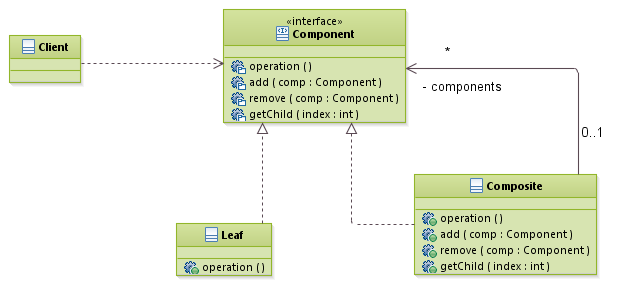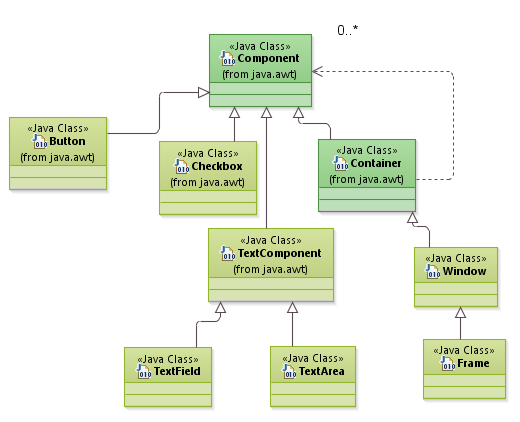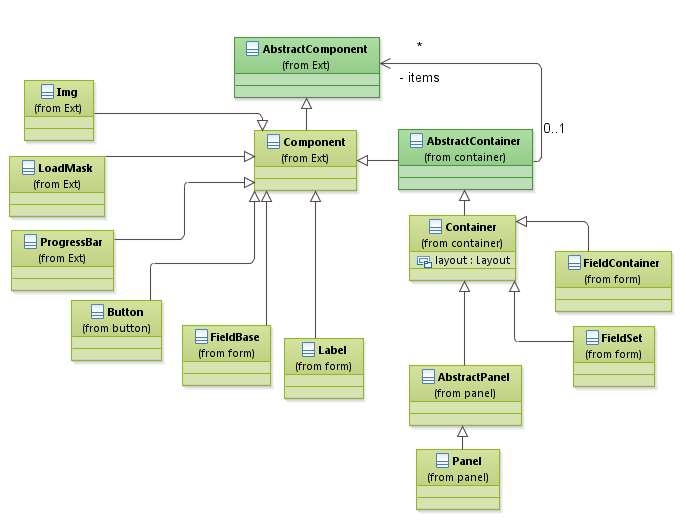组合模式
模式定义
组合模式将对象组合成树,来表现“整体/部分”的层次(树形)结构。组合模式能让客户端以一致的方式处理个别对象以及对象的组合。该模式牺牲了SIP原则来换取操作透明性。组合模式在GOF95中分类为结构型模式。
模式结构与说明

- 客户端使用Component接口操作组合中的对象
- Component定义了组合中所有对象的一致性接口(违反了父类只应当定义对子类有意义的接口这一设计原则)
- Composite有持有多个Component的引用,一般用集合表示。这些Component中可能仍然包含Composite
- 子节点可以持有父节点的引用,以便简化操作,例如删除自己
- 不管是Composite还是Leaf都可以通过operation()进行一致性操作,对客户端来说,这种操作具有透明性
- 对SIP原则的违反:Component一方面需要管理树形层次结构,一方面需要执行组件的增删查操作
组合模式的结构可以是递归的,组合模式具有两种组件,统称为节点(Node),其中不带子元素的节点称为叶子节点(Leaf),带子元素的则称为组合(Composite)。
组合模式牵涉到安全性与透明性的权衡问题:
- 安全性:从Client的角度来看更安全,不容易发生误操作,能访问的方法都是支持的功能。这需要把接口尽可能的下降到Leaf或者Composite中
- 透明性:从Client的角度来看,不需要区分Composite和Leaf。这需要把接口往Component中提升
这两者是冲突的,一般组合模式的实现,倾向于保证透明性,因为这是组合模式本身需要达到的效果。
应用举例
绿湾国际餐厅提供种类繁多的饮食,例如水产类、甜品类、饮料类,其中水产类还分为海鲜类、河鲜类。每种餐品都会标出是否素食、是否冷盘、口味等信息。为了便于客人快速的筛选产品,我们决定基于组合模式与迭代器模式来开发一个快速选菜程序。
|
1 2 3 4 5 6 7 8 9 10 11 12 13 14 15 16 17 18 19 20 21 22 23 24 25 26 27 28 29 30 31 32 33 34 35 36 37 38 39 40 41 42 43 44 45 46 47 48 49 50 51 52 53 54 55 56 57 58 59 60 61 62 63 64 65 66 67 68 69 70 71 72 73 74 75 76 77 78 79 80 81 82 83 84 85 86 87 88 89 90 91 92 93 94 95 96 97 98 99 100 101 102 103 104 105 106 107 108 109 110 111 112 113 114 115 116 117 118 119 120 121 122 123 124 125 126 127 128 129 130 131 132 133 134 135 136 137 138 139 140 141 142 143 144 145 146 147 148 149 150 151 152 153 154 155 156 157 158 159 160 161 162 163 164 165 166 167 168 169 170 171 172 173 174 175 176 |
/** * 菜单和菜单项的公共接口 */ public abstract class MenuComponent implements Iterable<MenuComponent> { /*操作都缺省适配为“不支持”,因为菜单和菜单项的本质差异 */ public void add( MenuComponent component ) { throw new UnsupportedOperationException(); } public void remove( MenuComponent component ) { throw new UnsupportedOperationException(); } public MenuComponent getChild( int index ) { throw new UnsupportedOperationException(); } public String getName() { throw new UnsupportedOperationException(); } public String getDescription() { throw new UnsupportedOperationException(); } public boolean isVegetarian() { throw new UnsupportedOperationException(); } public double getPrice() { throw new UnsupportedOperationException(); } } /** * 菜单项 * */ public class MenuItem extends MenuComponent { private String name; private String description; private boolean vegetarian; private double price; public Iterator<MenuComponent> iterator() { return new NullIterator(); } } /** * 菜单 */ public class Menu extends MenuComponent { private String name; private String description; private List<MenuComponent> menuComponents; public Iterator<MenuComponent> iterator() { return new ComponentIterator( menuComponents.iterator() ); } } /** * 菜单的迭代器,总是返回菜单本身,再依次迭代其子菜单/项 * @author WangZhen * */ public class ComponentIterator implements Iterator<MenuComponent> { private Stack<Iterator<MenuComponent>> stack = new Stack<Iterator<MenuComponent>>(); public ComponentIterator( Iterator<MenuComponent> iterator ) { stack.push( iterator ); //底层组合迭代器压在栈底 } public boolean hasNext() { if ( stack.isEmpty() ) { return false; } else { Iterator<MenuComponent> it = stack.peek(); if ( !it.hasNext() ) { stack.pop(); return hasNext(); //如果暂定迭代器空了,那么弹出并遍历下一个迭代器 } else { return true; } } } public MenuComponent next() { if ( hasNext() ) { Iterator<MenuComponent> it = stack.peek(); MenuComponent comp = it.next(); if ( comp instanceof Menu ) { stack.push( comp.iterator() ); //如果当前迭代项是Composite,那么压栈,紧接着遍历它 } return comp; } else { return null; } } public void remove() { throw new UnsupportedOperationException(); } } /** * 避免要求客户端代码采用if-else语句进行Null判断,进一步增强操作一致性 * */ public class NullIterator implements Iterator<MenuComponent> { public boolean hasNext() { return false; } public MenuComponent next() { return null; } public void remove() { throw new UnsupportedOperationException(); } } //测试代码 public static void main( String[] args ) { for ( MenuComponent comp : menu ) { //挑选出所有素食 if ( comp.isVegetarian() ) System.out.println( comp.getName() ); } } |
经典应用
UI框架中的组件层次
组合模式在UI框架中被大量的使用,例如Java中AWT的组件类层次结构如下:

其中Component是所有UI控件的超类,而Container则相当于Composite角色,一个Container中可以包含多种控件,包括其它Container。
ExtJS的组件框架的也包含组件模式的应用:

ExtJS中的CompositeElement
Ext.dom.CompositeElement实现了组合模式的变体,它虽然不支持树状结构,但是为Composite角色和Leaf角色提供了一致的接口:
|
1 2 3 4 5 |
//select方法返回CompositeElement var els = Ext.select("#some-el div.some-class", true); els.setWidth(100); //对组合设置宽度,相当于对所有元素设置宽度 els.hide(true); //设置所有元素的隐藏属性 els.setWidth(100).hide(true); //链式调用 |
在ExtJS中类似的组合模式还有Ext.fx.target.CompositeSprite、Ext.fx.target.CompositeElement等。
模式演变
- 与迭代器模式联用,用来遍历整个Component树
- 与访问者模式联用,可以把分散在Composite和Leaf类中的操作抽取出来,转移到访问者中
- 与职责链模式联用,可以方便的把职责分配到树节点上

Leave a Reply